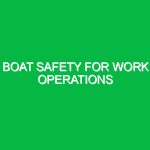Introduction
Water safety and drowning prevention are critical components of health, safety, and environment (HSE) practices. Every year, thousands of individuals lose their lives to drowning, a preventable tragedy that highlights the need for effective water safety measures. Understanding the importance of water safety not only protects lives but also fosters a culture of safety awareness that can save families from heart-wrenching loss.
In this article, we will delve deeply into the potential hazards associated with water activities, identify safety precautions, discuss best practices, and outline relevant regulations that govern water safety and drowning prevention. By the end of this exploration, you will have a clear understanding of how to mitigate risks and promote safety in and around water.
Understanding the Risks: Potential Hazards in Water Safety
Water environments, whether pools, lakes, rivers, or oceans, present unique hazards that can lead to drowning or injury. Here are some of the most common risks associated with water safety:
1. Inadequate Supervision
One of the leading causes of drowning is a lack of supervision. Adults often believe that children can safely play in water without constant oversight. However, a mere moment of distraction can lead to tragedy. It is essential to maintain vigilant supervision, particularly with young children, who can drown in just a few inches of water.
2. Poor Swimming Skills
Not everyone is a proficient swimmer, and many individuals overestimate their abilities. This is especially true for children, who may be eager to jump into the water without understanding their limits. Drowning can occur swiftly and silently, even in shallow water, underscoring the importance of swimming lessons for children and adults alike.
3. Environmental Factors
Natural water bodies pose unique risks, such as strong currents, sudden drop-offs, and unpredictable weather conditions. These factors can surprise even experienced swimmers. For instance, a calm lake can turn dangerous with a sudden storm, creating hazardous waves. Lifeguards and safety personnel should be trained to recognize and react to these conditions promptly.
4. Alcohol Consumption
Alcohol impairs judgment, coordination, and reaction time, significantly increasing the risk of drowning. Many drowning incidents occur during recreational activities, such as boating or swimming, where alcohol is present. It is crucial to avoid alcohol consumption in water-related activities or to designate sober supervisors.
5. Lack of Safety Equipment
Safety equipment, including life jackets, flotation devices, and safety ropes, can save lives. Unfortunately, many individuals neglect to utilize these resources, particularly in non-swimming environments like docks or during boating activities. It is vital to ensure that safety equipment is available and appropriately used.
Safety Precautions and Best Practices
Implementing effective safety measures can significantly reduce the risk of drowning. Here are some actionable best practices related to water safety and drowning prevention:
1. Active Supervision
Always designate a responsible adult to supervise children in or near water. This person should avoid distractions, such as using a phone or engaging in conversation, focusing solely on the safety of those in the water. The American Academy of Pediatrics recommends the “water watcher” approach, where one adult is designated to keep a constant eye on children during water activities.
2. Swimming Lessons
Enroll children and adults in swim lessons. The American Red Cross offers programs that teach essential swimming skills and water safety techniques. Even for those who are not strong swimmers, learning how to float and safely enter and exit the water can be life-saving.
3. Use of Safety Equipment
Ensure that life jackets are worn by those who are inexperienced swimmers or during water activities such as boating. The U.S. Coast Guard mandates the use of life jackets for certain watercraft. Make sure that the equipment is U.S. Coast Guard-approved and fits properly.
4. Establish Rules and Boundaries
Set clear rules for children regarding water play, such as no running around the pool area, no diving in shallow water, and no swimming alone. Teach children to respect these rules and understand the reasons behind them.
5. Emergency Preparedness
Create an emergency response plan that includes knowing how to reach emergency services quickly. Additionally, ensure that individuals present are trained in CPR and first aid. The ability to respond appropriately in an emergency can be the difference between life and death.
Regulations and Standards in Water Safety
Water safety and drowning prevention are governed by various regulations and standards at local, state, and national levels. Understanding these regulations can help ensure compliance and enhance safety measures.
1. Occupational Safety and Health Administration (OSHA) Standards
OSHA has established guidelines for water safety in occupational settings, particularly for workers involved in water-related activities. Employers must ensure that their employees are trained in safety practices and have access to necessary safety equipment.
2. American National Standards Institute (ANSI) Standards
ANSI has set forth standards for the design and operation of swimming pools and spas, which include guidelines for safety equipment, signage, and operational procedures. Compliance with these standards helps create a safe environment for recreational water activities.
3. State and Local Regulations
Many states have their own regulations regarding water safety, including requirements for lifeguards at public pools, fencing around residential pools, and safety signage. Familiarize yourself with local laws to ensure compliance and enhance safety in your community.
Real-Life Anecdotes: Lessons from the Field
While statistics can paint a grim picture of the drowning epidemic, real-life stories serve to illustrate the urgent need for water safety. Consider the case of a family who lost their seven-year-old daughter during a family outing at a local lake. The parents had assumed she was safe playing near the shore, only to realize too late that she had wandered into deeper water. This tragedy could have been avoided with consistent supervision and clear rules about water boundaries.
On a positive note, a community in Florida transformed its approach to water safety after a series of drowning incidents. They implemented a comprehensive water safety program that included free swimming lessons for children, regular safety workshops for parents, and a community water safety day. The initiative resulted in a significant decrease in drowning incidents, showcasing the power of education, community engagement, and proactive measures.
Conclusion
Water safety and drowning prevention are essential aspects of HSE that require collective effort and awareness. By understanding the risks, implementing safety precautions, and adhering to regulations, we can create safer environments for recreational water activities. Each of us plays a role in promoting a culture of safety, ensuring that our loved ones can enjoy water activities without the shadow of tragedy looming over them.
As we move forward, let’s commit to being vigilant and proactive in our approach to water safety. Whether it’s supervising children closely, enrolling in swimming lessons, or using safety equipment, every action counts in preventing drowning. Together, we can make our communities safer and reduce the heartbreaking incidents related to drowning, transforming our waterways from potential hazards into spaces of joy and recreation.


